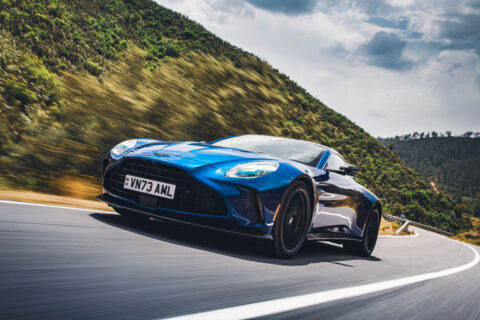Our drive was on both road and track, with a good amount of time dedicated to each, and on the road first, which I think is the better way around, giving good opportunity to see which modes suit it best. And on smoother asphalt, although it’s clear this is a more potent proposition, I don’t think its appeal has been made more focused. On its softest damper setting – called Sport – it does feel like an all-road kind of set-up. I’m told the dampers are quite good at separating primary and secondary ride and, fair enough, the Vantage does roll over most bumps confidently with no looseness of control. There’s a reassuring honesty to it, and a reasonable amount of agility. Aston did experiment with rear-steer but felt that it didn’t make the car predictably more agile, and that it’s sufficiently short enough to be a sports car without it. The steering is around 2.27 turns between locks and even in its lighter setting is settled in a straight line. I’d want a comparison test to be certain, but I think it’s less immediately responsive than, say, a Ferrari Roma’s. And while a Porsche 911 Turbo is a straight-line monster, the front-engined nature of the Aston makes it a confident car at speed. Does that limit its agility? Less than natural physics ought to dictate, one suspects. Weight distribution is 50:50 (a dry weight figure is the only one we’re quoted, at 1605kg), and the differential and damper responses are all routed through one big control systems module so they can monitor a driver’s inputs and hope to give what it thinks is the right outcome. A damper can allow a little lean at the front and the differential open itself completely to aid turn-in, for example, and then things can stiffen on exit to keep the car rotating. This means cars are a much greater tuning job than they used to be in order for them to feel natural, so it’s a credit that the Vantage does. It has absorbing, involving and naturally very engaging road dynamics, and steering that filters bad stuff and lets a modicum of good stuff through, whichever weight you choose. The lighter one is still middling, and I preferred it. There are five drive modes, from Wet through to Track, which adjust the dampers through three stages and the steering through two weights. A short press of the stability control system puts it into a lighter mode, an extended press turns it off and opens up a nine-stage traction control, which defaults to level five (for optimum launch), limits slip in level one, allows smoky getaways in eight and is all off in nine. The Monteblanco circuit near Seville, where we had a track outing, has some lumps on it, to the extent that Aston recommended Sport+ rather than Track damper settings. Road behaviour here is mostly just amplified, so what is an old-school front-engined handler can feel a bit clumsy until you get into it. On a constant throttle, there is a touch of steady-state understeer, as there should be, so it pays to plant the nose and keep it that way by slowly bleeding off of the brakes as you turn in. The steering weights up willingly and the rear starts to become more mobile. Get into it, and get it right, and it’s a charmingly capable bruiser, with a willingness to absorb mid-corner bumps and retain its composure, and slide around predictably if you choose. But I wonder if it does feel more at home as a road car. Rather satisfyingly, that’s fine: I suppose it should do. And there will surely be more track-happy versions to come.
